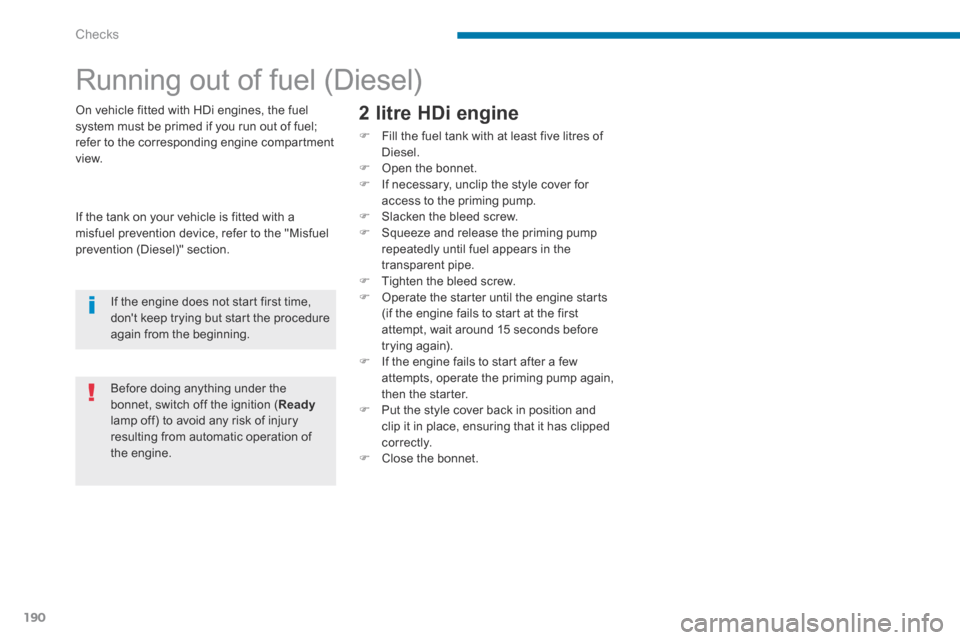Page 47 of 378

.Hybrid system45
Underbonnet precautions / warnings
The alternator-starter motor of your hybrid vehicle is also supplied at high voltage. If the vehicle ignition has not been switched off, there is a risk of the engine restarting at any time.
Always ensure that the ignition is switched off ( Ready lamp off) before opening the bonnet.
The high voltage battery must not in any circumstances be charged from an external source and must only be handled by a workshop technician. There is the risk of serious burns, as well as electric arcs that could cause serious injury or even death. A used Ni-MH (Nickel Metal Hydride) type high voltage battery must be removed in an appropriate manner by a repair workshop, so that its recycling presents no risk to the environment.
Emergency cut-off
Battery precautions
In the event of an accident, a cut-off system blocks the high voltage current and cuts off the fuel pump; your vehicle can no longer be started. To restart the hybrid system, contact a PEUGEOT dealer.
Before doing anything under the bonnet, to avoid the risk of serious injury switch off the ignition and verify that the Ready lamp in the dashboard is off. Also ensure that the ignition is switched off when refuelling to avoid the engine restarting.
Page 108 of 378

DIESEL
Access
106
To fill the tank safely:
When refuelling is complete: put the cap back in place, turn the key to the right, then remove it from the cap, close the filler flap.
Operating fault
A malfunction of the fuel gauge is indicated by the return to zero of the fuel gauge needle. Have it checked by a PEUGEOT dealer.
off) to avoid an automatic restart of the engine while refuelling, open the fuel filler flap, insert the key in the cap, then turn it to the left,
the engine must be turned off at the ignition switch (the Ready lamp must be
Quality of the fuel used for
Diesel engines
The Diesel engines are per fectly compatible with biofuels which conform to current and future European standards (Diesel fuel which complies with standard EN 590 mixed with a biofuel which complies with standard EN 14214) available at the pumps (containing up to 7 % Fatty Acid Methyl Ester). The B30 biofuel can be used in certain Diesel engines; however, this use is subject to strict application of the special servicing conditions. Contact a PEUGEOT dealer or a qualified workshop. The use of any other type of (bio)fuel (vegetable or animal oils, pure or diluted, domestic fuel...) is strictly prohibited (risk of damage to the engine and fuel system).
remove the cap and secure it on the hook, located on the inside of the flap, fill the tank, but do not continue after the 3rd cut- off of the nozzle ; this could cause malfunctions.
Page 109 of 378

4
Access107
Misfuel prevention (Diesel) *
Mechanical device which prevents filling the tank of a Diesel vehicle with petrol. It avoids the risk of engine damage that can result from filling with the wrong fuel. Located in the filler neck, the misfuel prevention device appears when the filler cap is removed.
Operation
* According to country of sale.
It remains possible to use a fuel can to
fill the tank. In order to ensure a good flow of fuel, do not place the nozzle of the fuel can in direct contact with the flap of the misfuel prevention device and pour s l ow l y.
When a petrol filler nozzle is introduced into the fuel filler neck of your Diesel vehicle, it comes
into contact with the flap. The system remains closed and prevents filling. Do not persist but introduce a Diesel type filler nozzle.
Travelling abroad
As Diesel fuel pump nozzles may be different in other countries, the presence of the misfuel prevention device may make refuelling impossible. Before travelling abroad, we recommend that you check with the PEUGEOT dealer network, whether your vehicle is suitable for the fuel pumps in the country in which you want to travel.
Page 192 of 378

Checks
190
Running out of fuel (Diesel)
2 litre HDi engine
Fill the fuel tank with at least five litres of Diesel. Open the bonnet. If necessary, unclip the style cover for access to the priming pump. Slacken the bleed screw. Squeeze and release the priming pump repeatedly until fuel appears in the transparent pipe. Tighten the bleed screw. Operate the starter until the engine starts (if the engine fails to start at the first attempt, wait around 15 seconds before trying again). If the engine fails to start after a few attempts, operate the priming pump again, then the starter. Put the style cover back in position and clip it in place, ensuring that it has clipped
c o r r e c t l y. Close the bonnet.
On vehicle fitted with HDi engines, the fuel system must be primed if you run out of fuel; refer to the corresponding engine compartment view.
If the tank on your vehicle is fitted with a
misfuel prevention device, refer to the "Misfuel prevention (Diesel)" section.
Before doing anything under the bonnet, switch off the ignition ( Readylamp off) to avoid any risk of injury resulting from automatic operation of the engine.
If the engine does not start first time, don't keep trying but start the procedure again from the beginning.
Page 193 of 378
10
Checks191
Diesel engine
The various caps and covers allow access for checking the levels of the various fluids, for replacing certain components and for priming the fuel system.
1. Power steering reservoir. 2. Screenwash and headlamp wash reservoir. 3. Coolant reservoir.
4. Brake fluid reservoir.
5. Battery / Fuses. 6. Fusebox. 7. Air filter.
8. Engine oil dipstick.
9. Engine oil filler cap. 10. Priming pump. 11. Bleed screw.